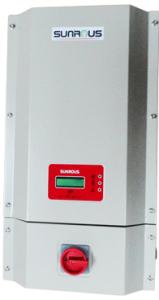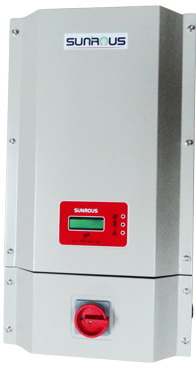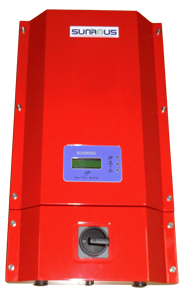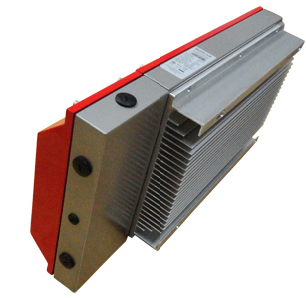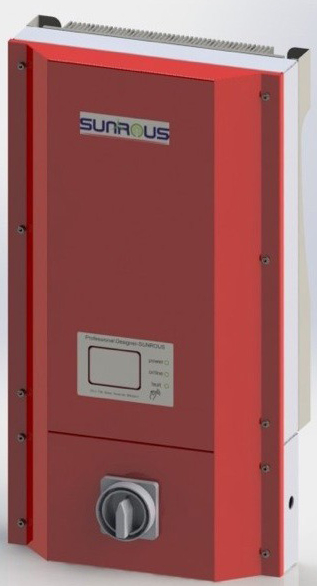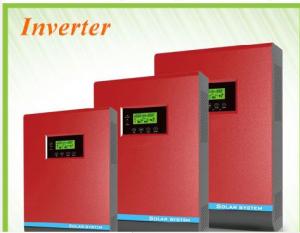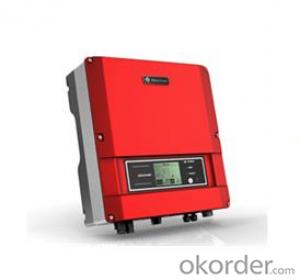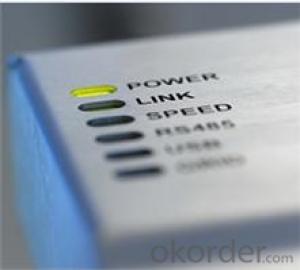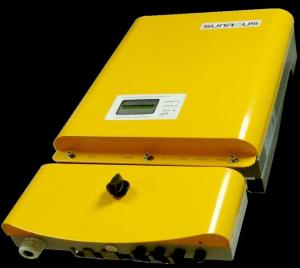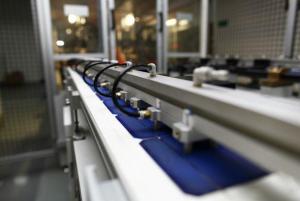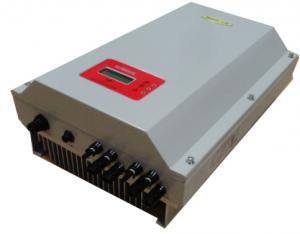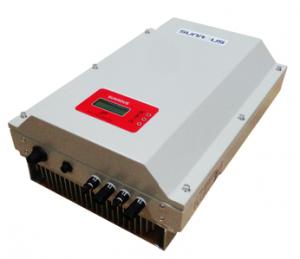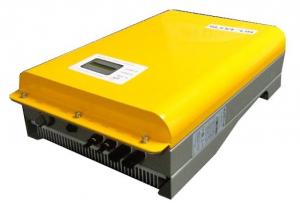Wifi Solar Inverter - PV Grid-Tied Inverter Dual MPPT US ETL Certificate
- Loading Port:
- Shanghai
- Payment Terms:
- TT or LC
- Min Order Qty:
- 10 pc
- Supply Capability:
- 1000 pc/month
OKorder Service Pledge
OKorder Financial Service
You Might Also Like
PV Grid-Tied Inverter-Dual MPPT-US ETL Certificate
Home Type HF series (UL Series)
· 10 years warranty
· Sealing stainless steel shell, suitable for indoor or outdoor installation
· High frequency transformer isolation
· The highest effciency achieves 98%
· Wide input Voltage range
· Adopt connectors type cable connection, Easy operation and installation
· Best tracking effciency with OptiTrac MPP control
· operating temperature range -25 ℃ to + 55℃
· High reliability due to complete protection function
· Anti-theft protection
· Plug-in grounding
HF series 1.5kw — 5.0kw

High frequency transformer isolation is the main feature of our production, which make Installation easier due to the reduced weight and higher conversion effciency because of omitting Low frequency transformer. The wide input voltage range from 180 to 600volt gives you extraordinary fexibility for you system design. Not need to set graphic display and RS485 communication system make the devices highly user-friendly.
This product can by multi-level parallel combination for 6kw to 20kw needed any power grade HF series technical parameter.
Datasheet:
GT3.6-ZX-01/HF | |
Input(DC) | |
Max.DC Power | 3600W |
Max.DC Voltage | 500V |
PV Voltage range, MPPT | 60V ~ 360V |
Max.input current | 30.0A |
Number of MPP trackers | 2 |
Max.number of strings (parallel) | 4 |
Output(AC) | |
Nominal AC power / | 3600W/3600W |
Max.output current | 16.0A |
Nominal AC Voltage / range | 180V~264V |
AC grid frequency / range | 47.5-51.5Hz / 59.3-60.5Hz |
Power factor at rated power | 1 |
THD | < 3% |
AC connection | Single-phase |
Efficiency | |
Max. efficiency/Californian efficiency | > 98.0% / > 97.0% |
MPP adaptation efficiency | > 99.0% |
Protection devices | |
DC reverse polarity protection | √ |
AC short-circuit protection | √ |
Ground fault monitoring | √ |
Grid monitoring | √ |
Output Transient Voltage Suppression | √ |
Over load | √ |
Anti-islanding | √ |
General data | |
Dimensions (W/ H / D) in mm | 370 / 540 / 185 mm |
Weight | 23kg |
Operating temperature range | -25 ~ +60℃ |
Storage temperature range | -40 ~ +70℃ |
Ambient humidity | 0 ~ 100% |
Consumption (night) | < 0.5W |
Topology | HF-transformer galvanic isolation |
Cooling concept | Convection |
Enclosure type | IP65 / NEMA 3R |
Features | |
DC connection: PV special connector | √ |
AC connection: connector | √ |
LCD display & Backlit | √ |
LED display | √ |
Interfaces: RS485 | √ |
Warranty: 10 years | √ |
Certificates & approvals | G83 / G59 / TUV / SAA / ETL / JET/ CE |
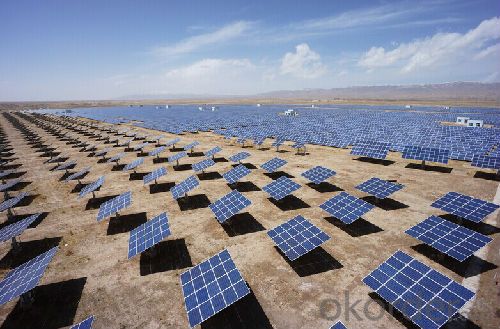
- Q: How does a solar inverter affect the overall system cost?
- A solar inverter can have a significant impact on the overall system cost. While it is a crucial component that converts DC power generated by solar panels into AC power for use in homes or businesses, it also adds to the total expenses of installing a solar system. The cost of a solar inverter depends on factors such as its capacity, efficiency, and features. Higher capacity or more advanced inverters tend to be more expensive. However, investing in a high-quality inverter can improve the overall efficiency and performance of the solar system, potentially offsetting the additional cost in the long run.
- Q: What is the role of a grid connection feature in a solar inverter?
- The role of a grid connection feature in a solar inverter is to allow the solar power system to connect and interact with the electrical grid. This feature enables the solar inverter to convert the direct current (DC) produced by the solar panels into alternating current (AC) that is compatible with the electrical grid. It ensures that excess solar energy can be fed back into the grid, allowing the system owner to receive credit or payments for the electricity generated. Additionally, the grid connection feature allows the system to draw power from the grid when solar energy is insufficient, ensuring a reliable and continuous power supply.
- Q: Can a solar inverter be used with solar-powered emergency backup systems?
- Yes, a solar inverter can be used with solar-powered emergency backup systems. The solar inverter is an essential component that converts the DC (direct current) power generated by the solar panels into AC (alternating current) power, which can be used to power various electrical devices and appliances during emergencies.
- Q: Can a solar inverter be used with different types of batteries?
- Yes, a solar inverter can be used with different types of batteries, as long as they are compatible with the inverter's specifications and voltage requirements.
- Q: What is the role of a solar inverter in reactive power compensation during grid disturbances?
- The role of a solar inverter in reactive power compensation during grid disturbances is to regulate and stabilize the flow of reactive power between the solar PV system and the grid. During grid disturbances, such as voltage fluctuations or power factor variations, the solar inverter can actively inject or absorb reactive power to maintain the voltage and power factor within acceptable limits. This helps in improving the overall stability and reliability of the grid system, ensuring efficient power transfer, and minimizing any adverse effects on the grid and connected electrical devices.
- Q: Are solar inverters weatherproof?
- Yes, solar inverters are designed to be weatherproof. They are typically built to withstand various weather conditions such as rain, snow, and extreme temperatures. However, it is always recommended to consult the manufacturer's specifications and guidelines to ensure proper installation and protection against environmental factors.
- Q: Can a solar inverter be used with a solar-powered telecommunications system?
- Yes, a solar inverter can be used with a solar-powered telecommunications system. A solar inverter is an essential component of a solar-powered system as it converts the direct current (DC) generated by solar panels into alternating current (AC) that can be used to power various electrical devices, including telecommunications equipment. By using a solar inverter, the solar-generated electricity can be efficiently utilized to run a telecommunications system, making it a sustainable and environmentally-friendly solution.
- Q: What is the role of a solar inverter in a solar-powered telecommunications system?
- The role of a solar inverter in a solar-powered telecommunications system is to convert the direct current (DC) produced by the solar panels into alternating current (AC) that can be used to power the telecommunications equipment. It also ensures that the AC power is stable and at the necessary voltage and frequency for the proper functioning of the system.
- Q: How does a solar inverter handle voltage stability in the grid?
- A solar inverter handles voltage stability in the grid by continuously monitoring the voltage levels and adjusting its output accordingly. It maintains a stable voltage by regulating the power output from the solar panels and injecting or absorbing reactive power as needed. This helps to stabilize the grid voltage and prevent fluctuations that can disrupt the operation of electrical devices and appliances connected to the grid.
- Q: What is the maximum AC power output of a solar inverter?
- The maximum AC power output of a solar inverter varies depending on the specific model and capacity. It can range from a few hundred watts for small residential inverters to several megawatts for large commercial or utility-scale inverters.
Send your message to us
Wifi Solar Inverter - PV Grid-Tied Inverter Dual MPPT US ETL Certificate
- Loading Port:
- Shanghai
- Payment Terms:
- TT or LC
- Min Order Qty:
- 10 pc
- Supply Capability:
- 1000 pc/month
OKorder Service Pledge
OKorder Financial Service
Similar products
Hot products
Hot Searches
Related keywords
